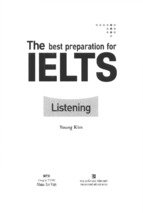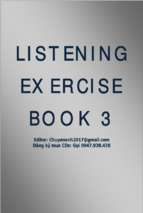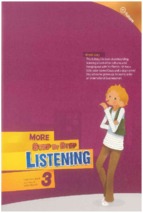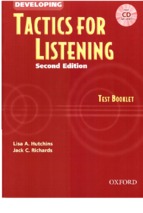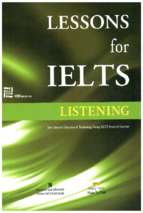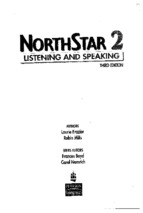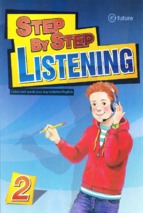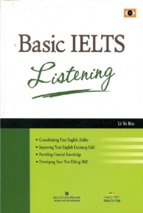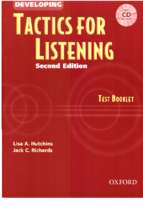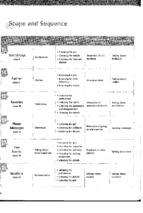Sách phương pháp dạy Nghe.
Pearson Education Limited
Edinburgh Gate
Harlow
Essex
CM20 2JE
England
and Associated Companies throughout the world.
www.longman.com
© Pearson Education Limited 2008
All rights reserved; no part of this publication may be reproduced, stored in a retrieval system, or transmitted,
in any form or by any means, electronic, mechanical, photocopying, recording, or otherwise, without the prior
written permission of the Publisher.
The Publisher grants permission for the photocopying of those pages marked ‘photocopiable’ according to the
following conditions. Individual purchasers may make copies for their own use or for use by classes they teach.
School purchasers may make copies for use by their staff and students, but this permission does not extend to
additional schools or branches. Under no circumstances may any part of this book be photocopied for resale.
The rights of J. J. Wilson to be identified as the author of this Work have been asserted by him in accordance
with the Copyright, Designs and Patents Act 1988.
Printed in Malaysia (C T P-W P)
Produced for the publishers by Stenton Associates, Saffron Walden, Essex, UK. Text design by Keith Rigley.
Illustration on page 62 by Phillip Burrows.
ISBN 978-1-4058-4775-9
Acknowledgements
We are grateful to the following for permission to reproduce copyright material:
Macmillan Education for an extract from American Inside Out Pre-Intermediate Student's Book by Sue Kay,
Vaughan Jones and Philip Kerr copyright © Sue Kay, Vaughan Jones and Philip Kerr 2002; and Inside Out
Elementary Student's Book by Sue Kay and Vaughan Jones copyright © Sue Kay and Vaughan Jones 2002.
Reproduced with permission; Oxford University Press for pages 56 and 57 from Headway Teacher’s Book
Elementary level by John Soars & Liz Soars, 1993; page 64 from Headway Activity Book Elementary level by Tim
Falla, John Soars & Liz Soars, 1994; 2 figures from Clockwise Classbook Advancedlevel by Amanda Jeffries 2001;
and an extract from Natural English Student's Book Intermediate level by Ruth Gairns & Stuart Redman, 2002
copyright © Oxford University Press; Pearson Education for pages and extracts from the following Advanced
Matters: Student's Bookby Bell 8c Gower, 1999; Cutting Edge: A PracticalApproach to Task Based Learning: Advanced
Student Book by Sarah Cunningham & Peter Moor, 2003; Market Leader Upper Intermediate: Coursebook NE
by David Cotton, David Falvey and Simon Kent, 2005; New Cutting Edge Intermediate: Student's Book by Sarah
Cunningham & Peter Moor, 2005; Sky 2 Students Book by Brian Abbs and Ingrid Freebairn, 2005; Intelligent
Business Pre-Intermediate: Course Book by Christine Johnson, 2006; Total English Intermediate: Student's Book
and DVD Pack by Antonia Clare and JJ Wilson, 2006; New Opportunities Pre Interm ediately Harris and Mower,
2007 and Total English Advanced: Student's Book and Advanced Workbook by Antonia Clare and JJ Wilson, 2007
copyright © Pearson Education Limited; PFD for the poem ‘Smithereens’ by Roger McGough from In the
Glassroom by Roger McGough copyright © 1976 Roger McGough, reproduced by permission of PFD on behalf
of Roger McGough; Thomson Learning for extracts from Innovations Elementary 1st edition by Dellar and
Walkey 2006, reprinted with permission of Heinle/ELT a division of Thomson Learning www.thomsonrights.
com Fax 800 730-2215; and Warner/Chappell Music Ltd for the lyric reproduction o f ‘Wonderful Tonight’
Words 8c Music by Eric Patrick Clapton © 1977 EC Music Ltd. All rights administered by Warner/Chappell
Music Ltd, London W6 8BS, Reproduced by permission.
For my parents, David and Elizabeth, with love and thanks.
Contents
Page
Introduction
7
1
Listening in the world and in language learning
• T he why and how of listening - motivation and mechanics
• T he characteristics o f spoken English
• W hy listening is difficult
• B ottom -up versus top-dow n approaches to listening
• W h y students should listen to English
• T he place of listening in language teaching
• Communicative Language Teaching (CLT)
• H earing English in context
• Listening and language learning - six myths?
2
Listening texts and listening strategies
25
• W h a t makes a good listening text?
• A uthentic versus pedagogic
• Strategies good listeners use
• Different types o f listening text and different processes required
3
Listening sources, listening tasks
• T he characteristics o f effective listening
• Different sources o f listening
o Teacher talk
o Student talk
o G uest speakers
o Textbook recordings
o Television, video, D V D and radio
o Songs
o T he Internet
• Types o f comprehension exercise
• H ow to create tasks
40
4
Pre-listening skills and activities
• Listening in the lesson - the sequence
• T he role o f the teacher
• W h a t a listener needs to know before listening
• Activating schemata/predicting
• Establishing reasons for listening
• G enerating questions
• Pre-teaching vocabulary
• Things to avoid during the pre-listening stage
60
4
9
5
While-listening skills and activities
• W hy use while-listening activities?
• Listening for gist
• Listening for detail
• Inferring
• Participating actively
• N ote-taking
• Dictation
• Listen and do
81
6
Post-listening skills and activities
• Reflecting
• Checking and summarising
• Discussion
• Creative responses
• Critical responses
• Information exchange
• Problem-solving
• Deconstructing the listening text
• Reconstructing the listening text
96
7
Preparation and planning
• T he teacher as planner
• Listening in the syllabus
• Choosing and adapting published materials
• A uthentic materials: radio, film/TV, songs
• Anticipating problems
• Young learners
• ESP (English for specific purposes)
• Six essentials for planning listening lessons
111
8
Listening in the w ider context
• Integrated listening
• H ow to assess listening
• Encouraging students to listen outside the classroom
• Self-access and listening in the language lab
• Teacher autonomy; becoming a better teacher of listening
134
Task File
Task File Key
Chapter notes and further reading
Glossary
Index
146
165
178
184
190
5
Acknowledgements
How to Teach Listening benefited enorm ously from the input of a wonderful team of
colleagues, friends and family. I am extremely grateful to the following people, who read
early drafts of the m anuscript: my father, David H enry Wilson, who has read pretty much
everything I’ve w ritten of consequence since I was three, and always found brilliant ways
to improve it; my sister, Jenny Wilson, a superb editor with an eagle eye; Nick Dawson, my
friend and colleague, for his ideas, injections of hum our and dedication (while sitting up
in a hospital bed in the sum m er of 2007, he insisted on reading a chapter of the unfinished
manuscript); and my wife and best friend, Alexandra Neves, for her perceptive comments
and her support. Thanks also to the anonym ous readers for their excellent suggestions,
many of which found their way into the final draft of the book.
I’d like to thank the Pearson team, particularly Jeremy Harm er and Katy W right for
their invaluable help in shaping the book, and also my outstanding editor, Helena Gomm,
whose expertise, patience and good hum our were m uch appreciated. Thanks are also due to
Kate Goldrick for keeping the whole project on track, and for the behind-the-scenes work
of Sharon Buss, Jane Reeve, David Briscoe and Eddi Edwards. I would finally like to thank
my long-time collaborator on other projects, Antonia Clare, for her encouragement.
/. /. Wilson
New Mexico, USA
6
Introduction
Listening should be impossible. Fluent speech is a motorway pile-up. One word crashes
into the next, and the individual sounds - just like the rear and front ends of cars - are
‘concertinaed’ out of shape. This is why children love saying, ‘I scream for ice cream’,
and why one learner once misheard ‘the stuffy nose can lead to problems’ as ‘the stuff he
knows can lead to problems’. Indeed, when individual words are extracted digitally from
recording tape, thereby taken out of their context of connected speech, they are mainly
unrecognisable, even to native speakers.
Furthermore, the things listeners do - pick up acoustic signals, re-imagine them into
words, turn the words into meaningful sentences, organise the sentences into propositions
using linguistic and non-linguistic contexts - are bewilderingly complex cognitive
processes. W hen the acoustic signal is in a foreign language, the processes become more
complex still. And yet many language students manage to listen successfully, to maintain
conversations, chat with strangers, follow directions to Harrods and listen to radio soap
operas and lectures on astrophysics.
How to Teach Listening will answer several questions about the skill: Why do we do it?
How do we do it? And the core of the book: How can we (teachers) help others (students)
to get better at it?
The book opens with a general discussion of listening, and the main principles behind
listening in the ELT classroom. This first chapter, ‘Listening in the world and in language
learning’, also gives the reader the background to some of the debates (bottom -up versus
top-down theories, for example) and the research findings that have influenced the way we
conceptualise and speak about listening.
In Chapter 2, ‘Listening texts and listening strategies’, we look at what makes good
listening texts and how students can deal with them. There is also a discussion of the merits
of authentic versus inauthentic listening texts - a topic much in debate in recent years. In
Chapter 3, ‘Listening sources, listening tasks’, we discuss where to find listening material and
what our students might do with it. This chapter also assesses different types of listening
text (from television, coursebooks, the Internet, etc).
We then move on to the very practical core of the book. Chapters 4, 5 and 6 provide
a num ber of pre-, while- and post-listening skills and activities, plus discussion of the
principles behind them. These chapters should give any teacher, of however limited
experience, the tools to teach a listening lesson competently. Here we deal with a num ber
of activities and skills, ranging from the long-established - activating schema and listening
for gist - to more innovative ideas stemming from recent developments in ELT.
Chapter 7 covers a num ber of areas that will concern teachers, such as adapting
materials, anticipating problems and planning the listening com ponent of specialised
courses like business English or English for young learners.
Finally, Chapter 8, ‘Listening in the wider context’, discusses long-term development
for both the teacher and the student. In many ways this is the most im portant chapter in
the book as it looks at how students can continue to improve their listening outside the
classroom and beyond the duration of any formal course. It also deals with professional
7
development for teachers. The chapter considers issues such as assessing listening, using
the language laboratory and action research.
How to Teach Listening has been w ritten for teachers, teacher trainers, directors of
studies and materials writers involved in teaching English as a foreign language. While the
book caters for teachers with little or no experience in the EFL classroom, more experienced
teachers will find fresh ideas and perspectives on the teaching of listening. In general, How
to Teach Listening assumes that the classroom has some form of equipm ent to expedite the
use of recorded material, but the book also provides ideas for the many teaching situations
in which power cuts are comm on, technology is unavailable or untrustworthy, and the
teacher’s voice is the only reliable form of listening input.
Suggested classroom activities are signalled by this icon.
J. J. Wilson
New Mexico, USA
Listening in the
world and in
language learning
We have two ears and one mouth so that we can listen twice as much as we speak. (Epictetus)
■ The why and how of listening
- motivation and mechanics
■ The place of listening in
language teaching
■ The characteristics of spoken
English
■ Communicative Language
Teaching (CLT)
■ Why listening is difficult
■ Hearing English in context
■ Bottom-up versus top-down
approaches to listening
■ Listening and language
learning - six myths?
■ Why students should listen to
English
The why and how of listening - motivation and mechanics
Animals listen either to stay safe or to get food. Frogs can hear predators and other frogs
but nothing else. Kangaroos can hear the scales of a rattlesnake scraping on sand. Bats find
their dinner by squeaking and listening to the echoes bouncing off nearby insects. Humans,
on the other hand, listen not only for the sound of lions growling in the night and babies
crying for food, but also to lectures, grand speeches of all lengths (Fidel Castro’s used to
go on for hours, apparently), idle chit-chat, radio broadcasts, instructions and, of course,
foreign languages. From the small child listening out for the melodious bell of the ice cream
van to the adult tuning in to airport announcements, we listen prim arily because there are
things we need to know. We learn to listen and we listen to learn. But hum ans also listen to
Beethoven and The Beatles, bedtime stories and bad jokes. Why? Because, unlike animals,
hum ans have another reason to listen: sounds can stimulate the imagination and enrich
our lives.
The prim ary purposes of hum an listening, then, are information-gathering and
pleasure, though there are other reasons, such as empathy, assessment and criticism. The
types of listening we engage in on a day-to-day basis can be categorised as follows:
9
Chapter 1
Listening for gist
This refers to the occasions when we want to know
the general idea of what is being said, as well as who
is speaking to whom and why, and how successful
they are in communicating their point.
Listening for specific information
This refers to the occasions when we don’t need to
understand everything, but only a very specific part.
For example, while listening to a list of delayed trains,
we are only interested in hearing news about one
particular train - the one we want to catch - and so
we listen selectively for this specific information. We
ignore everything else.
Listening in detail
This refers to the type of listening we do when,
for example, we need to find errors or determine
differences between one passage and another. We
cannot afford to ignore anything because, unlike
listening to a list of delayed trains, we don’t know
exactly what information will help us to achieve our
task.
Inferential listening
This refers to the type of listening we do when we
wish to know how the speaker feels. It may involve
inferring, which is dealt with in more detail in
Chapter 5 .
As for the ‘how’ of listening, nothing can happen w ithout sound waves. These are caused
by movement - the w hirr of a bat’s wings, the trem or of a violin string, the vibrations of
the vocal chords, all of which move the air around them. Sound waves need conductors
through which to travel, such as air or water (the tagline from the film Alien - ‘In space no
one can hear you scream’ - is literally true because there is no air, water or other conductor
o f sound in space). The sound waves are then ‘received’. Unlike spiders, which detect sound
through the hair on their bodies, or grasshoppers, which ‘hear’ with their legs, we have
ears, specially formed for receiving sound waves. The outer ear catches these vibrations,
which then pass through the middle ear, consisting of the ear drum , bones and membranes,
and then through the cochlea (nam ed after the Latin for a shell, because of its snail-like
shape), which is part of the inner ear. Finally, the sound waves are interpreted by the brain,
and if we are really listening (that is, concentrating on the message) as opposed to merely
hearing (when the same process takes place but w ithout a sustained focus on the part of the
recipient), we may then laugh, cry or slouch off to do our homework.
The characteristics of spoken English
In recent years, with the advent of text-messaging and chat rooms, writing has begun to
assume some of the features of speaking: informality, lack of attention to punctuation,
transience, real-time interaction. As leremy H arm er writes, ‘on the Internet, live sessions
are not called chats by accident’. Indeed, the word ‘chat’, for many teenagers and children, is
associated more now with reading and w riting than speaking and listening.
10
Listening in the world and in language learning
Listening and reading both involve the decoding of messages, but there are, of course,
significant differences between the two. Firstly, reading takes place over space - pages,
signs, the backs of envelopes - whereas listening takes place over time. Most oral data is
not recorded and has no perm anent record. It is based on spontaneous performance, an
invisible ink that usually disappears from the mem ory within seconds.
Because listening takes place over time, not space, the gaps between words that exist in
writing do not exist in speech, so the listener imagines them into being. This segmentation
of words from the flow of speech (recognising word boundaries) is often problematic for
listeners and occasionally amusing. Rock guitarist Jimi Hendrix didn’t sing, ’scuse me while
I kiss this guy, but ’.scuse me while I kiss the sky, and, if you believe one well-known linguist,
the words of the hymn, ‘Gladly my cross I’d bear’ are routinely thought to be about a cross
eyed bear. In fact, to listeners, speech sometimes comes across like this:
W herctherearen o n atu ralp au scscau sed b y th esp eak er’sbrcathingtheflow ofspcechisonelongsound.
Another key difference between listening and reading is that listening involves getting to
grips with features of pronunciation such as elision, assim ilation and intrusion.
Elision is when sounds are omitted, usually from the beginning or end of a word, in
order to make pronunciation of the utterance easier for the speaker. For example:
She sat next to the wall.
The t of next is elided into the t of to so that it becomes /neksts/, but we know that she did
not sit necks to the wall (we can safely assume that she only has one neck).
Assimilation takes place when the first of a series of sounds changes to accommodate
subsequent sounds. This often happens because the tongue cannot get into place quickly
enough during connected speech to articulate the next sound. For example:
Tony’s a heart breaker.
The t sound in heart changes to either a glottal stop or a p in this context: (/ha:pbreika/),
though Tony breaks girls’ hearts, not harps.
Intrusion is when a sound is added in order to allow the speaker to link two words
more easily. For example:
He doesn’t have an original idea in his head.
Speakers of British English often add an intrusive r sound between idea and in (/aidisrin/);
it sounds as though he doesn’t have an original ‘eye-deer’ in his head, whatever that may
be.
Another feature of pronunciation is that formulaic phrases are often chunked; this
means the phrases are said rapidly as if they are one word. For example:
/nsuwDdaimiin/ for know what I mean?
/gimi:obreik/ for give me a break
All of these are potentially problematic for listeners, though not for readers. For a more
detailed analysis of pronunciation, see How to Teach Pronunciation.
A further difference between listening and reading is that listening is often interactive:
two or more people in face-to-face contact. This means that non-verbal comm unication
- for example, body language - plays a role, and of course listeners are often able to ask
11
Chapter 1
questions, signal lack of understanding, interrupt, etc, which readers cannot do. This is why
emoticons - those smiley faces in email correspondence such a s ;) (a winking face, denoting
irony) - were invented for writers (not all writers are fans; Geoffrey Nunberg wrote that the
word emoticon ‘deserves to die horribly in a head-on collision with infotainment’). W hen
reading, we have to rely far more on our inner voice, words that we form in the m ind but do
not say aloud, whereas the spoken word always contains an element of performance. Pitch,
intonation, tone, volume and patterns of stress can all make words come alive. Conversely,
great speeches and riveting court cases, when later read as transcriptions, often come across
as m ind-num bingly dull simply because the dram a of live interaction is missing.
O ther features of this interactivity include forms for signalling attention, such as Hey!
and vocatives, which are ways of addressing someone (M um, honey, Jim, mate). These
features are seen infrequently in writing. Question tags (e.g. haven’t you? didn’t she?) appear
in approximately a quarter of all questions uttered in conversation, while in academic prose
they form less than 1 per cent. O ther ways of eliciting a response in conversation include
greetings, farewells and response elicitors such as Okay? and See?
The spontaneity involved in m ost speech (lectures are an exception, and these often
contain many of the features of writing) means that false starts, hesitation, redundancy and
ungram m atical sentences are extremely com m on, whereas writing usually involves wellformed sentences and careful advance planning. In m ost formal or semi-formal writing,
deviations from standard gram m ar are rare - at least among proficient writers.
Finally, we should m ention the status of listening in relation to reading. Storytelling
is an ancient art, while writing, as done by the general public, is a relatively m odern
phenom enon. In the past, literacy was solely for the ruling classes and the clergy. But w ritten
docum ents have status because they have permanence. They are also associated with vital
encoded inform ation such as the law, national constitutions, contracts, gas bills. Back in
1923, the London Stock Exchange adopted its m otto ‘My word is my bond’, but these days
an oral agreement doesn’t count for m uch in the eyes of the law. As M ark Twain once said,
‘Oral contracts - they ain’t w orth the paper they’re w ritten on’. A boss w anting something
guaranteed will say ‘Give it to me in w riting’.
Because literacy is so closely bound to inform ation and vice versa, and because literacy
has to be taught (whereas listening to LI, a person’s first language, comes naturally), most
m odern educational systems, and therefore societies at large, emphasise reading above
listening.
Why listening is difficult
Many of the differences between reading and listening illustrate just why listening is
considered a difficult skill. The difficulties can be grouped into four general categories:
characteristics of the message, the delivery, the listener and the environment.
Characteristics of the message
Some time during the 1980s a software company was dem onstrating its latest product:
speech recognition technology. A m em ber of the audience was invited to say a sentence
which would then be ‘recognised’ by a com puter and displayed in w ritten form for all to
see. The participant, deciding to stay on topic, said, ‘It’s hard to recognise speech’. The
com puter promptly, and to much laughter, flashed up, ‘It’s hard to wreck a nice beach’.
12
Listening in the world and in language learning
This story may be apocryphal - although Bill Gates admits that Microsoft’s speech
recognition group calls itself the Wreck a Nice Beach group - but it is a small illustration
of the problems (for computers and people!) involved in listening to connected speech.
As Rick Altman wrote, ‘For us [teachers], listening is like reading speech. For students it is
more like finding the objects hidden in the drawings of trees’. Knowing the w ritten form of
a word is no guarantee that students will recognise the spoken form. As already mentioned,
recognising word boundaries is problematical, but also the irregular spelling system of
English does not help matters. A sentence (however unlikely) such as:
M r Clough from Slough bought enough dough.
would probably cause problems for students to pronounce even if they ‘knew’ the
words, because of the variety of ways in which one combination of letters (ough) can be
pronounced.
There are also, of course, ‘slips of the ear’ - simple mishearing - as when the antihero of Bret Easton Ellis’s novel American Psycho hears ‘murders and executions’ instead of
‘mergers and acquisitions’ (although some would call this a Freudian slip, bearing in m ind
the character’s m urderous habits).
O ther linguistic difficulties include unknow n words, lexical density (short spaces of
time between content words, forcing the listener to concentrate harder), and complex
grammatical structures. Non-linguistic characteristics of the message include familiarity
of the topic, text type and cultural accessibility. We will deal with all of these in more detail
in Chapter 2.
Characteristics of the delivery
Mode of delivery is a vital factor. It may be helpful here to distinguish between reciprocal
and nonreciprocal listening. Reciprocal listening involves interaction between two or more
people; in other words, there is a conversation. Reciprocal listening allows the use o f repair
strategies: speakers can react to looks of confusion by backtracking and starting again;
listeners can ask for clarification, ask the speaker to slow down, etc.
Nonreciprocal listening describes a situation in which the listener has no opportunity
to contribute to a dialogue, for example while watching television or listening to the radio.
In these situations, the listener’s lack of control over the input is a crucial issue. The listener
has no influence over factors such as the speed at which the speaker talks, the vocabulary
and gram mar used, and no recourse to asking for repetition of a word if the speaker’s
pronunciation renders it incomprehensible. It seems surprising to us now, b u t when
American ‘talkies’ were first shown in the cinema in Britain, audiences had great difficulty
in understanding the American accent.
For all of the above reasons, nonreciprocal listening is usually regarded as more difficult
than reciprocal listening.
O ther characteristics of delivery include organisation (do the speakers ramble on,
jum ping from topic to topic, or are they concise?), duration, num ber of speakers (the more
speakers, the more difficult it is to follow the conversation) and accent. We will look at these
more closely in Chapter 2.
13
Chapter 1
Characteristics of the listener
As any teacher can testify, some students get sidetracked easily and simply lack the ability
to sustain concentration. O ther students have problems motivating themselves to listen.
These are often long-term issues.
Yet other students learn better using modes that are different from listening. According
to M ultiple Intelligences theory, people possess different ‘intelligences’, such as linguistic,
logical-mathematical, spatial, bodily-kinaesthetic, musical, interpersonal, intrapersonal
and naturalist. These can be related to preferred modes of learning. Most people, at some
unconscious level, realise they are more predisposed to one way of learning than to another.
Someone with musical intelligence may choose to learn a language through listening to
songs; someone with bodily-kinaesthetic intelligence m ight prefer to learn by acting,
moving to sounds or physically piecing together words on wooden blocks.
Besides the students’ individual dispositions, there is the age factor. Young learners can
be loosely categorised as anything from the age of seven or eight (younger than this may
be considered very young learners) up to those in their m id to late teens. Students at this
age differ from adults considerably in their needs as listeners. Some of these differences
may include shorter attention spans, fewer cognitive abilities, difficulties concentrating on
disembodied voices and the im portance of visual stimuli and music. A nother consideration
is children’s familiarity and confidence with m ultim edia material, particularly when they
reach their teenage years, which often surpasses that of older generations. We will look at
the challenges of planning lessons for young learners in Chapter 7.
At the other end of the scale, older learners - those above the age of seventy, for
example - sometimes have difficulties with listening due primarily to physiological factors.
These m ight include declining abilities in hearing in general or problems w ith short-term
memory. Teachers of older learners may need to proceed more slowly with instructions and
they may also find that their students’ ability to cope with fast connected speech lags behind
the students’ cognitive abilities. The ideas contained in Chapter 7 for adapting materials are
applicable for such students.
Some tem porary characteristics that affect listening might include anxiety (for example,
in test conditions), tiredness, boredom or the listener having a cold (blocked sinuses affect
the aural system).
Characteristics of the environment
Environmental conditions which may affect listening performance include the tem perature
of the room (hot rooms induce sleep), background noise (heavy traffic, for example) or
defective equipm ent which affects the clarity of a recording.
A nother problem which does not fit neatly into any of our other categories is the role
of m em ory in listening. As we process one word, another word is ‘incom ing’. The m ind gets
flooded with words. Unless we are well attuned to the rhythm and flow of the language,
and the way in which a piece of discourse is likely to continue, this can lead to overload,
which is one of the m ain reasons why students ‘switch off’. The idea may be heresy to
poets, but the m ind isn’t really concerned with individual words. We tend not to remember
these with any exactitude, but rather the general meanings that they convey. Jack Richards
states that ‘m em ory works with propositions, not with sentences’. Many of our students are
faced w ith badly-conceived tasks that test their m em ory instead of guiding them towards
comprehension, an issue that will be dealt with in Chapter 3.
14
Listening in the world and in language learning
Related to mem ory is the process of activating the listener’s prior knowledge, a
technique that can help to reduce the mem ory load. We describe this process as activating
schemata. W hat is a schema? Imagine I say that I am going to the bank. Your mental model
of this activity probably goes something like this: a person walks towards a brick building,
pushes open a door made of wood and glass, and stands in a queue for half an hour. This
is your schema for ‘going to the bank’. Supposing, instead, I walk up to the bank, put on
my ski mask, pull out my shotgun and shout, ‘Everybody hit the floor! This is a stick-up!’,
your schema for ‘going to the bank’ is tem porarily short-circuited. You revert, instead, to
your schema for ‘robbing a bank’. You probably imagine that I will now say something
like, ‘Hand over the money!’ to the cashier, as this is a part of the mental model for bank
robberies. If I then pause, put my shotgun down, turn to the m an in the director’s chair and
say, ‘I forgot my line. Can we do that again?’, you need to ‘retune’ your schema once more
in order to understand the situation. A schema, then, is a mental model based on a typical
situation.
Activating the students’ schemata allows them to tune in to the topic and helps them to
develop their expectations of the input, a crucial factor in getting them to predict content.
There are many ways of activating our students’ schemata (showing pictures and asking
questions are among the most common), as we will see in Chapter 4.
Bottom-up versus top-down approaches to listening
Listening, then, is difficult for many reasons. While examining the difficulties, researchers
have tended to use two models to describe the listening process. These are the bottom-up
model and the top-down model. The bottom -up model emphasises the decoding of the
smallest units - phonemes and syllables - to lead us towards meaning. The approach is
based on discrete units of language in the text.
The top-down model emphasises the use of background knowledge to predict content.
This may refer to world knowledge, knowledge of the speaker or context, or analogy (if the
situation is familiar, listeners can guess what they’re going to hear next). The top-down
model is based, at least in part, on the listener; much of the comprehension relies on what
happens in the m ind before the listening has even begun, whereas the bottom -up approach
depends more on the sounds heard.
There has been much debate in recent years about which model is most salient when we
listen to foreign languages. Until fairly recently it was assumed that most errors in listening
comprehension were caused by students mishearing individual words - a failure of the
bottom -up process. Celce-Murcia and Olshtain, quoting a study of academic listening,
report one student hearing ‘com m unist’ when the lecturer said ‘com m onest’, and another
student hearing ‘plastic bullets’ instead of ‘postal ballots’. Michael Rost reports that a
lecturer said, ‘another factor [promoting bilingualism] is m igration’ and one student later
wrote a sum m ary stating that ‘one factor is vibration’.
Recent research, however, suggests that it is often top-down approaches that cause
mistakes in listening tasks, a typical occurrence being that the students know the topic,
hear some familiar vocabulary and make wild guesses about the content. It is an area of
ongoing research, but what we can say with some certainty is that we use both processes
simultaneously when we listen, something that is known as the interactive model.
15
Chapter 1
We have so far dealt with the characteristics and difficulties of listening, and a model
comm only used to describe the process. These sections are the ‘how’ of listening. Now we
turn to the ‘why’. Why do students need to listen to the language?
Why students should listen to English
On 19 August 1991, Mikhail Gorbachev, then the President of the Soviet Union, was placed
under house arrest in his dacha - a holiday hom e - in the Crimea, while eight of his hard
line colleagues attem pted a coup. The plotters announced that Gorbachev ‘was unable to
perform his presidential duty for health reasons’. W hen Gorbachev emerged three days
later to be restored to power, he surprised the world by announcing that in order to find out
what was going on in his country he had listened to the BBC World Service - a bad coup for
the plotters (seven were arrested, the eighth killed himself) but a good one for the BBC.
Earlier in the chapter we stated that people listen prim arily for inform ation and
pleasure. Here we will look at the reasons for listening specifically to English. There are
actually two questions subsumed in the title of this section: 1) Why English (as opposed to
Finnish, German or Xhosa)?; and 2) Why listen (as opposed to read, write or speak)? The
first answer to the first question, as Gorbachev’s experiences testify, is access to the world.
Access to the world
Ever since Paul Julius Reuter started sending news by carrier pigeon in 1850, to be followed
shortly afterwards by the founding of Reuter’s news agency in London (its growth was
based on journalistic scoops such as the assassination of President Lincoln), the spread of
international news has been dom inated by Britain and the US. Today, although there are a
num ber of large media organisations growing rapidly in other countries, m ost foreign news
on the w orld’s television screens comes from either Reuters (UK) or APTN (a US company).
Besides these media giants, the BBC was founded in 1922 to broadcast over the radio, and
its first Director General, John Reith, announced that the company should ‘inform, educate
and entertain’. These are also three very good reasons for listening to English.
Pleasure
Perhaps even more than through news and inform ation-sharing, the English language
has spread through entertainm ent, prim arily Hollywood and pop music. For many
students, music is the first contact point with English and it can be a great motivator,
especially for teenagers who want to understand just what it is that well-known singers
like Coldplay, Eminem or Britney Spears are really singing. For young learners, who have a
shorter concentration span than older students and little experience of the world to apply,
enjoyment is one of the main criteria for any activity.
Travel/tourism
Music crosses borders easily, and so do people. It is often the case that the com m on language
between the traveller and the host, wherever he or she may be, is English. For this reason
English is sometimes called a lingua franca. It is a tool for international comm unication.
Work purposes and academic requirements
English is the international language of the seas (sailors have their own dialect called Seaspeak,
based on a simplified version of English), of medicine, science and technology. All over the
16
Listening in the world and in language learning
world, conferences serving almost any m odern field of inquiry - biotechnology, quantum
physics - often take place in English. This also means that as an academic requirement in a
num ber of fields, the ability to comprehend spoken English becomes mandatory.
Business, too, in the age of globalisation, has come to rely on English as the common
language for people from disparate nations. For many individuals, job prospects, status,
financial reward and opportunity for travel all depend partly on their English. Furthermore,
companies seeking to expand beyond their own borders realise they will often need to
operate in what is sometimes called international English, a variety that some regard as
simplified.
These are all valid reasons for listening to English, but it m ust be conceded that no one
knows how long the language will retain its predom inant position. While the dominance
of English is, of course, connected with historical and political factors such as colonisation,
which are beyond the scope of this book, it must also be m entioned that Spanish, M andarin
Chinese and Arabic are also spreading rapidly.
So far in this section we have mainly focused on the question ‘Why English?’, and looked
at ‘real world’ reasons for listening to the language. We will now move on to ‘Why listen?’
and examine some of the methodological reasons for listening.
The place of listening in language teaching
O f the four skills (reading, writing, listening and speaking) that are generally recognised
as the keys to ‘knowing’ a language, listening is probably the least understood, the least
researched and, historically, the least valued. David N unan describes it as ‘the Cinderella
skill’, overshadowed by its big sister, speaking.
In the past, foreign languages were learnt mainly by reading and translating rather than
listening. In the second half of the twentieth century, increased research into how people
learn both first and second languages, as well as developments in linguistics, sociology and
anthropology, led to an understanding that listening is probably the key initial skill. After
all, we cannot talk w ithout listening first.
Another factor that led to changes in foreign language education was spying. During
the Second World War the US’s Army Specialized Training Program trained a num ber
of soldiers to learn foreign languages. These soldiers spent years studying gram m ar and
vocabulary from books, but when it came to actually speaking the language in order to
infiltrate a country or to listen in on enemy conversations over the radio waves, their
language skills were inadequate. The authorities realised that a new methodology was
required, and this is how Audiolingualism came into being.
Audiolingualism, which uses recorded drills (the development of technology, including
the widespread use of recording equipm ent in classrooms, was significant), put listening
at the forefront of language teaching pedagogy. The idea was based on a premise from
psychology called behaviourism, in which the subject responds to a prom pt in order to
gain a reward. In the context of language learning, students were to hear passages - mainly
dialogues - which contained the target grammatical patterns, and then the students
would repeat the pattern, thereby ‘learning’ it. The reward, in this case, consisted of a
better understanding of the language. The syllabus would include structures o f gradually
increasing complexity.
17
Chapter 1
W hole generations studied English by sitting at a console in a language laboratory,
endlessly repeating ‘The book is on the table’, and thousands of them succeeded, even if the
listening passages that they used were neither natural nor contextualised.
Then Noam Chomsky famously disputed the idea that people could learn languages
through habit-form ation. He put forward the idea of generative grammar, arguing that
language could not be delimited to a fixed num ber of sentences, but that people were capable
of expressing an infinite num ber of thoughts, and that pedagogy should reflect this. With
the growing popularity of Chomsky’s ideas, Audiolingualism’s days were num bered, to be
replaced in the 1970s by more hum anistic methods. The centrality of listening, however,
remained, and was reinforced by the work of Stephen Krashen.
Listening was at the forefront of Krashen’s input hypothesis. According to Krashen,
languages are acquired when people understand messages (he called these messages
comprehensible input). The input hypothesis is consistent with what we know about
children’s LI acquisition. A parent says to a toddler, ‘Pass me the paper, please’ or ‘Put
your hat on’. Although the child may not say anything, he or she is taking in the language
during this silent period and the brain is storing it all up, categorising words, parsing verbs,
examining meaning. A few m onths later the child begins to speak.
Although Krashen produced little empirical evidence, the theory appealed to com m on
sense and became extremely influential in the field of second language acquisition (SLA)
studies. The m ethodology that Krashen designed in order to put this and other theories
into practice was called The Natural Approach, which places listening at its centre, with the
teacher speaking to the students (telling stories, etc), but not necessitating an oral response
from them. The language was to be graded according to the natural order in which people
acquire L2 (for example, the present perfect is ‘late acquired’ and so would not feature on
the syllabus until the students were fairly proficient).
The input hypothesis and the silent period also formed the basis for James Asher’s
m ethodology called Total Physical Response (TPR). The principles behind it were: learning
LI and learning L2 are similar processes; listening comes before speaking; delaying the need
to speak alleviates stress on the learner; children and adults respond well if asked to react
physically to speech. In practice, students were to hear instructions given by the teacher and
act upon them; for example, the teacher would say ‘Stand up’ and the student would do so.
There was no pressure on students to speak.
Some practitioners would argue that the techniques of TPR are to be used sparingly
(after all, a linguistic diet of comm ands is probably only useful for future drill sergeants), and
mainly with beginners, elementary levels and children. However, the activities in TPR can
provide a pleasant change of pace in language classes, and are good for the type of learners
who enjoy learning by moving around. A nother benefit is that TPR activities require little
preparation. Besides giving orders, a num ber of variations can be useful for a sagging class
(these will be dealt with in Chapter 5), and the technique has been incorporated into many
game-like activities that can serve as a non-threatening way to get, and react to, input.
Input
The idea of input has been central in the elevation of listening to its recent status in
language learning. But what does aural input consist of? A short answer is: any aspect
of the language. A carefully scripted piece of input for the language class will contain
target gram m ar and/or target vocabulary. More natural input will probably also contain
18
Listening in the world and in language learning
discourse markers, examples of pragmatic use of language, features of intonation, etc.
Input gives opportunities for incidental vocabulary learning - when students pick up
on words/phrases by chance and circumstance rather than by the design of a materials
writer or teacher. Incidental vocabulary learning often comes about because the topic, and
the vocabulary learnt, may be of personal interest to the listener. Perhaps he or she really
needs the words to accomplish a personal goal. This type of vocabulary learning - achieved
because of personal interest or necessity rather than, say, the demands of a coursebook - is
often more memorable for students so they are more likely to retain the words in the long
term.
We can make a distinction between roughly-tuned and finely-tuned input. Roughlytuned input is only approximately at the students’ level; it permits them to understand the
message although there may be many aspects of this message that elude comprehension.
An example of roughly-tuned input might be a teacher telling the students a story. Here,
the features in italics may be beyond an intermediate student’s production, but the whole
passage is comprehensible:
‘Well, I read something in the paper the other day on a very similar theme, basically
looking at which cities are the best to live in. It took into account various criteria, such as
cost of living, safety, education, transport system, and so on. And I think it came up with
a list of about twenty, and of these, five were in Switzerland.’
Finely-tuned input is more carefully controlled. It doesn’t contain complex grammatical
constructions or vocabulary far beyond the students’ current level, and is designed so as not
to distract the students from the target grammar/vocabulary. In some cases, finely-tuned
input may contain only structures and vocabulary that the students have already covered
on the syllabus. Here is an example of finely-tuned input for a low-intermediate class:
‘So, I used to work in Belgium, in Brussels, actually. And I used to travel to work by car,
’cos I used to have a Ford ... you know a Ford, a type o f ... make of car? And it used to
take me about, about twenty minutes to get to work. OK?’
The passage above, as you’ve probably guessed, is designed to present used to.
In practice, students benefit from a combination of roughly-tuned and finely-tuned
input, the one for more natural examples of language use, the other to provide crystal clear
examples of target grammar.
Communicative Language Teaching (CLT)
The 1970s saw the first stirrings of Communicative Language Teaching (CLT). This has
been widely, though not universally, adopted, and in developed countries is arguably the
dom inant methodology. It emphasises the use of English for real com m unication rather
than dem onstration (or ‘display’) of target gram m ar and vocabulary. Using inform ationgap activities, role-plays, games, discussion of real issues, etc, CLT seeks to engage the student
on a personal level through meaningful interaction and personalisation. TPR is often seen
as a form of CLT, but one difference is that CLT, in its broader use, encourages dialogue
from the start. Even with very little English at their disposal, students attem pt to develop
communicative competence using any means they can - gesture, mime, interlanguage
(this is the student’s attempts at L2, which may not be grammatically correct but form part
of the developmental stage towards proficiency), etc.
19
Chapter 1
CLT brought with it significant developments in terms of listening to L2. It emphasised
authenticity of materials, contexts and responses. The passages students listen to in a
com m unicative approach tend to be closer to real-life use of language than was the case
in, say, Audiolingualism, which often used contrived dialogues as carriers of the target
gram m ar. CLT uses findings from research into pragmatics, discourse analysis and
sociolinguistics in order to show how real com m unication takes place, instead of an
idealised version.
The other main development in listening in CLT stems from the ways in which the
passages are used - in other words, what the students do with them. In CLT there is more
room for personal, emotional or critical responses to the content, and less emphasis on
drilling and repetition. Listening in CLT has a communicative purpose in that students
are expected to use the inform ation they hear, just as we do when we listen outside the
classroom.
Hearing English in context
No m atter w hat m ethodology or approach we use, a characteristic product of language
teaching is fragments. Most methodologies around the world use a language syllabus that
is incremental, so, for example, students half learn the present perfect one day, then some
items of a lexical set the next, etc. Learning a language is like assembling a jigsaw puzzle.
Jigsaw puzzles tend to be more easily completed when we have an idea of what the whole
will look like. Similarly, listening to a piece of extended discourse gives the students a
whole, complete view of what English sounds like. Listening, then, can m om entarily bring
together the fragments.
Listening to English in context also reminds us that appropriacy - the right words for
the right social context - and register - the degree of formality - are vital factors in the goal
of communicative competence. Imagine a foreign student going to a job interview in a New
York bank and greeting the interviewer with, ‘Hey, man, how are you doing?’ The English
is correct, but the register is too informal. Language use occurs in authentic contexts which
involve hum an relationships and ‘fixed’ situations that may require formulaic language
in order to proceed smoothly. Sometimes we teach English - and our students perceive
English - as if it is an abstract system in a context-free world of its own. Listening reinforces
the im portance of context.
A model for speaking
Language is prim arily an aural/
oral phenom enon. Most students,
when asked why they are studying
English, say that they want to
speak the language. Relatively few
say‘I want to improve my reading/
w riting’.
One thing that listening can
do is to provide a model, or an
ideal, for students to aspire to,
copy or learn from. If our students
hear highly proficient speakers
20
2
H H Listen to three speakers and answer
the questions. What does each speaker talk
about? Are they having a moan, raving about
something or taking a stand? What are their
opinions?
3
Prepare to moan, rave or take a stand about an
issue of your choice. Use the pictures opposite
to help you if you need inspiration.
- Xem thêm -




